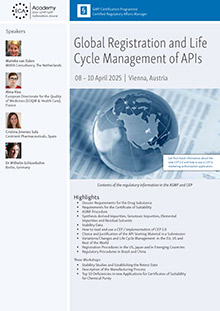MRA - STRENGTHENING THE COLLABORATION OF FDA AND EU
With 01 November 2017, the EU-FDA Mutual Recognition Agreement (MRA) regarding GMP inspections of manufacturers of human medicinal products came into operation. It started with the recognition of the FDA by the EU and the first eight EU Member States by the FDA. "By partnering with these [EU] countries we can create greater efficiencies and better fulfill our public health goals, relying on the expertise of our colleagues and refocusing our resources on inspections in higher risk countries," said FDA Commissioner Scott Gottlieb, M.D. in an FDA press release from 31 October 2017.
The need for more efficiency becomes more obvious when looking at some figures which were presented by FDA's Matthew Scherer at the 12th QP Forum of the European QP Association on 30 November/01 December 2017 in Budapest. Matthew Scherer is Assistant Health Attaché and International Program and Policy Analyst, FDA Office of International Programs - Europe Office in Brussels.
Back in 2011, the FDA had 957 registered facilities in the European Union (EU) and 888 in China and India. These numbers increased over the last years, as the figures show (see image 1).
In response, the FDA allocated additional resources to expand international inspection activities. In 2016, the FDA inspected 32% of the 1224 drug facilities in the EU. Five percent of these inspections led to an 'Official Action Indicated' classification. In the same year, already 1.476 facilities in China and in India were registered. 21% of the facilities in China and 23% of them in India were inspected. From the facilities inspected in China, 22% got an 'Official Action Indicated' classification as did 14% of those inspected in India. Still, more international inspections are performed in the EU (see image 2).

Image 1: FDA registered drug facilities in 2016, as presented by Matthew Scherer

Recommendation
Berlin, Germany9/10 April 2025
KPIs and Quality Metrics

Image 2: FDA inspections throughout the world, as presented by Matthew Scherer
However, the risk in other countries seems to be higher. From all the import alerts issued in 2016, 12% were issued in the EU, 36% in China and 28% in India. These numbers demonstrate the potential value of the FDA and EU relying on each other's inspection results. The finalization of the MRA allows FDA and the EU to mutually accept inspections and ultimately allow the regulators to better direct resources to manufacturing facilities in other countries where there may be higher risk. But establishing this agreement was not easy. In his presentation, Matthew Scherer talked about some of the issues the FDA needed to better understand - like, for example, the EU's conflict of interest policy for drug investigators, inspector qualifications and variability of the inspectorates within 28 different Member States. On the other hand, the EU had similar questions about the FDA inspectors and processes and was concerned about possible variability across the FDA district offices and the need for complete and not redacted inspection reports.
The QP Forum's speakers' panel comments further indicated what issues make it more complicated to set up the agreement. For example, currently the reporting of inspection results is generally different. EU inspectorates issue GMP certificates after a successful inspection. These certificates are entered in the EudraGMDP database and are needed for regulatory purposes and for import and supplier qualification activities. But, with the implementation of the MRA, these EU-GMP certificates will not be issued any longer. And the FDA does not issue GMP certificates. The FDA also does not classify inspection results in the same manner as the EU.
Matthew Scherer acknowledged that as a challenge. As he mentioned there is "a lot more work to do regarding how we will efficiently share inspection information under the agreement", but establishing a classification rating similar to that in the EU is not planned. Matthew Scherer pointed out that there may be opportunities to leverage existing compliance databases - FDA's Compliance Status Information System (COMSTAT) and EU's EUDRAGMDP - for information exchange.
COMSTAT is a database that contains the compliance status information on approximately 30,000 domestic and foreign drug, medical device and biologics facilities. FDA's Office of Regulatory Affairs maintains the user accounts that can be made available to foreign regulatory agencies. However one of the EU inspectors present in the panel was sceptical that the information available in the COMSTAT database was sufficient to effectively implement mutual recognition.

Recommendation
Hamburg, Germany29/30 April 2025
Efficient Batch Record Design and Review
Another challenge is the translation of inspection reports. From the FDA's perspective the EU and/or the Member States are responsible for translation of FDA inspection reports from English into the national language. However, FDA does expect to manage translation of reports from the EU into English when necessary.
And what about Quality Metrics? In 2015 the US Food and Drug Administration (FDA) had started an initiative in order to use so-called quality metrics for the planning of their risk-based inspections. The FDA wishes that, after becoming effective, manufacturers will convey defined quality scores to the FDA via an electronic portal. The FDA will use these to calculate specific statistics which are supposed to allow a risk-based management and planning by the FDA. The question was raised how this will further develop with regard to the MRA. Matthew Scherer said that this initiative remains a priority and that "understanding the state of quality of a drug product and manufacturing facility will help FDA develop compliance policies, predict drug shortages and promote innovative quality management systems".
At the end Matthew Scherer summarized "the amended Mutual Recognition Agreement cements the FDA and EU's collaboration by taking concrete steps to rely upon each other to benefit public health".
Author:
Wolfgang Schmitt
... is Operations Director and organises and conducts courses and conferences on behalf of the ECA Academy in the areas QA, GMP and GDP.



